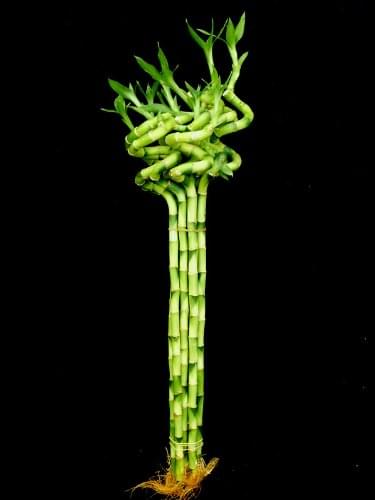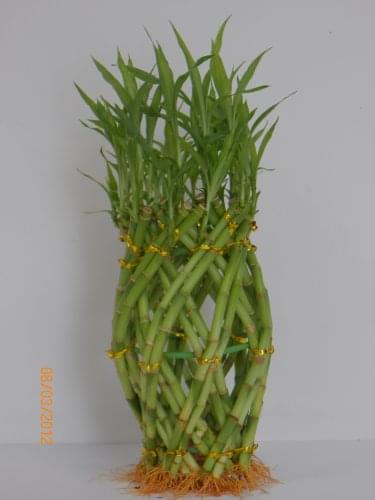Last Updated on June 15, 2023 by Grow with Bovees
There are over a 1000 known bamboo species in the world, where some remarkable giants tower 100-feet in the air, and other shrub-like plants grow only a few feet tall.
Then there’s lucky bamboo, or Chinese bamboo — a plant that looks like true bamboo, but is also called Dracaena or Dracaena Sanderiana, and is sold in most home and garden stores.
Even though the leaves and stems look similar to bona fide outdoor bamboo plants, lucky bamboo makes a great indoor plant that loves water, and grows best in high humidity conditions.
If you notice your lucky bamboo leaves turning yellow, then this should be a reason for concern.
There are myriad reasons for the leaves turning yellow, most notably low soil nutrients, over watering or lack thereof, or boggy soil.
Reasons For Lucky Bamboo Plant Turning Yellow
If you notice just a few leaves yellowing and dropping, then it’s probably nothing to worry about.
But, if there are several parts of your bamboo turning yellow, then this could indicate a more serious problem.
The most common factor for yellowing leaves is too salty and heavily-fluoridated tap water and/or too much sunlight.
Another big reason your leaves are turning yellow could be lack of water or nutrient deficiency.
If the leaves as well as the bamboo stalks of the plant are slowly turning yellow, this could be a plausible sign of over fertilization.
The leaves may also turn yellow due to injury caused by plucked leaves, broken stems, vigorous pruning, damage from pets, or from extreme heat or cold.
These plants need bright but filtered or indirect light, such as when placed on a table next to a sunny window.
If you place the bamboo under direct sunlight, then it may be susceptible to sunburn, causing the leaves to turn yellow.
Yellow leaves can also develop on your lucky bamboo plant if it isn’t getting enough light, and this in most cases happens before it develops a yellow stem.
One of the noteworthy traits of these plants is that they don’t need much water to survive.
However, if you’re growing smaller lucky bamboo plants in a vase with water, the water may have gotten too low at some point, resulting in drying of the stem, and eventually the leaves, causing them to turn yellow.
How to Fix Bamboo Leaves Turning Yellow
If your bamboo plant is showing leaf discoloration, then there’s no need to break a sweat yet, as there are several ways to revive the leaves and/or the plant itself. Here are a few bamboo care tips;
1. Check Your Water, Avoid Chlorinated Water
Most indoor water sources are rich in chlorine, which can cause the leaves of the lucky bamboo plant to turn yellow.
Low levels of chlorine shouldn’t harm your plant too much, but it’s best to use filtered water, distilled water or rain water.
However, if chlorinated tap water is the only source of water for your lucky bamboo plants, you can still use it by dissipating the chlorine.
You can prepare the water by pouring a small quantity in a bowl, and letting it sit overnight. This will allow the chlorine to evaporate.
An easier idea is to make the switch to filtered water for all of your indoor potted plants, they will all benefit from this.
2. Maintaining a Consistent Temperature
Lucky bamboo does well in temperatures between 65–95 °F (35 °C), which is mostly the same temperature in most homes and offices.
But you should refrain from keeping them under air conditioners or heater vents, as the draft can alter the temperature quite a bit, and cause leaf and stem yellowing of your plants.
3. Clean Your Bamboo Bowls
Many avid gardeners grow lucky bamboo in bowls and vases, potted in the best store bought compost you can find. If you’re a novice gardener, then something to take note of is that lucky bamboo is one of those plants that grow well in water.
First thing to do is quench your plant’s thirst with the right amount of water, which can be done by taking a closer look at the plant’s roots and then measuring.
The right water level should be a maximum two inches above the roots. The water should also be replaced every 10 days to keep the plant happy and healthy.
If you don’t replenish the water in the bowl in this time period, you risk the growth of algae, which can cause plant injury.
Further, don’t forget about the bowl or vase, because algae can accumulate in there as well, and spread to the roots of the plant quickly.
4. Overwatering and Underwatering
If you’re growing in soil, then make sure you keep it slightly damp at all times.
Even though bamboo does not need much water, it’s a plant after all, and all plants need some water to survive.
But it’s easy to get carried away with the watering, and overwater your plant. If your bamboo sits in soggy soil, it has a chance of developing root rot, which is something to be avoided.
If you aren’t sure about how much water your plant needs or if it needs any at all, you can perform a soil test by pressing your finger gently on the surface of the soil, and checking if it’s wet or dry.
If the soil feels dry, then you’ve got to water the plant, and if moist, don’t water it until the soil feels a bit dry.
5. Fertilize Periodically
Just like watering, you need to fertilize your lucky bamboo plant every so often. Regardless of whether you’re growing your lucky bamboo plant in water or soil, you still need to apply fertilizer once or twice a year.
When you first bring your lucky bamboo plant home, don’t apply fertilizer for at least a couple of weeks.
Yellow leaves are also caused by over fertilization, so if you’ve fertilized the plant already, then change the water, and don’t add fertilizer for at least a couple of months.
Liquid fertilizer is a great choice for lucky bamboo, and you don’t need a whole lot. With regard to the best time to fertilize lucky bamboo, set your fertilization schedule to once in the spring, and a second application in the summer only if you feel the plant needs it.
6. Pruning Lucky Bamboo
If the leaves of the lucky bamboo plant have turned yellow, great chances are that they’re either dying or dead. So, grab a pair of pruning scissors, and prune the yellow leaves to encourage regrowth of fresh, green leaves.
But it’s not only the yellow leaves that need pruning. You should also cut back on any thin, overlong or crooked shoots to a length of around one to two inches from the stalk. Don’t change the number of lucky bamboo stalks though, check what the number of lucky bamboo stalks mean according to feng shui.
Final Thoughts
If the leaves on your bamboo plant are turning yellow, then they may be dried out or dead.
But bamboo leaves turning yellow is not a sign of a dead plant, and there are several ways to revive the plant to grow fresh green leaves.
Two of the most important things to do is to avoid feeding the bamboo plant chlorinated water, and second keep a close eye on the temperature in your space.
When cared for properly, lucky bamboo can live for approximately one to two years, and will shed and replenish its leaves during its lifetime.

